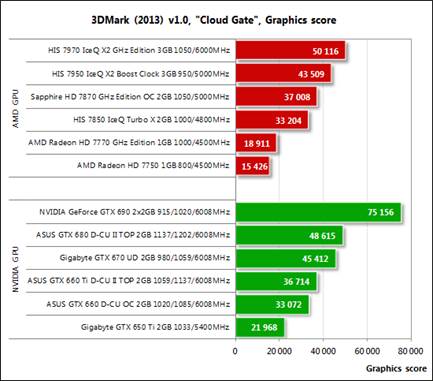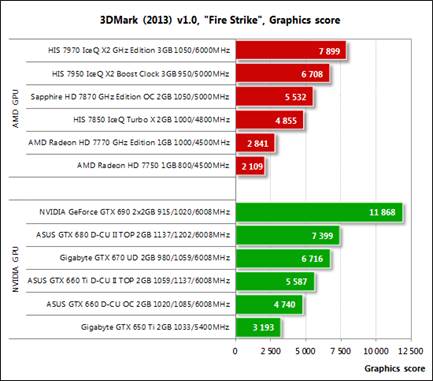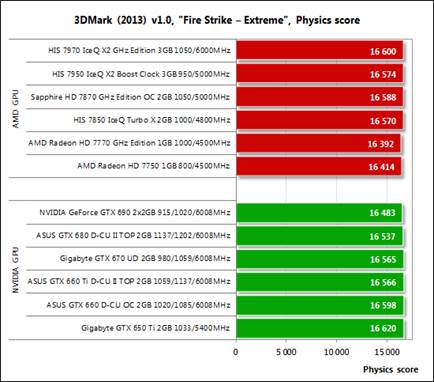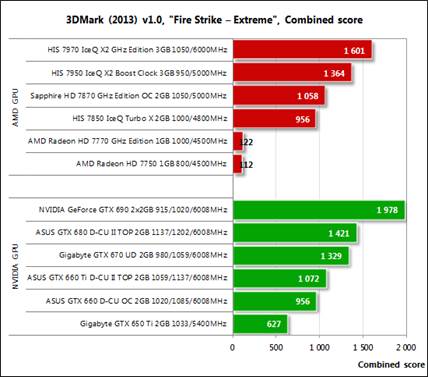Ice
Storm

Ice
Storm is not able to express the full potential
As expected, the Ice Storm could not reveal
the full potentials of most graphics cards we tested, because their performance
is limited by the CPU and platform. Although we used a six-core CPU, high-end
cards which offer the same performance, while the GeForce GTX 690
dual-processor is a bit faster than the Radeon HD 7970 single processor.
The scores even varied more in the mini graphics
tests, but, as we shall see later, did not reflect the performance situation well
enough.

Products
based on Nvidia excelled in the low-price market.
Anyway, we can notice that while graphics cards
are not much different in the high-end market, the products based on Nvidia are
superior in the low-price market.
The mini physical test used a single core CPU,
leaving the GPU in idle mode. Here are the results:

Using
only one CPU core
Our testing operated at the same rate
regardless of the types of cards based on AMD that we installed. Nvidia-based
cards made outputs more volatile. Measurement standards developers actually
warned that this could happen because the load would be too slow for modern
desktops.
Cloud
Gate

Cloud
Gate is more complex, but not enough to reveal differences
The Cloud Gate situations are more complex than
Ice Storm, but not complex enough to reveal differences between the modern
graphics cards. However, the mini graphical tests provided some interesting figures:

The GeForce
GTX 690 is still in the leading place
The GeForce GTX 690 is still in the leading
place. It will still be the world's fastest graphics card until the Titan GeForce
or the AMD processor card appears. The following is the Radeon HD 7970, which
is followed closely by the GeForce GTX 680. The GeForce GTX 670 competes with the
Radeon HD 7950. In the medium price market, we saw that the Radeon HD 7870
competed with the GeForce GTX 660 Ti and the Radeon HD 7850 competed with the
GeForce GTX 660. All of them obviously were overclocked by the factory. The pair
of AMD-based cards for the new user market is much slower than the GeForce GTX
650 Ti; however, the AMD can only make them appealing through the low prices.
There is nothing to compare in our physical
tests that used all 6 cores of the CPU:

The
physical test
We can only predict the accuracy of the
measurements here.
Fire
Strike

Fire
Strike
Fire Strike was a different story. This
situation used encrusted stone, shiny maps, post-processed filters, and many
other effects. As a result, loading the graphical system was very high, which makes
it easy for us to compare graphics cards with each other, especially for the graphics
scores:

Comparing
graphics cards scores with each other
The GeForce GTX 690 was 50% faster than the Radeon
HD 7970 here. The latter, in its turn, was better than the GeForce GTX 680, but
then the picture changed. The GeForce GTX 670 was not slower but faster than
the Radeon HD 7950. The GeForce GTX 660 Ti was similar to the Radeon HD 7870,
and the GeForce GTX 660 was equal to the Radeon HD 7850. Judged by the results
of 3DMark, AMD should make up for the gap between the Radeon HD 7850 and the HD
7770 with a few new products because the GeForce GTX 650 Ti is preferred more
than the Radeon HD 7770 among those most reasonable mid-priced gaming graphics
card.
The mini physical test ddid not need our
comment:

The
physical testing
AMD-based products seemed to be preferred in
the mini-test combined with where both the CPU and the CPU were loaded.

AMD-based
products seemed to be preferred.
Again, it did not include the Radeon HD 7770.
Fire
Strike Extreme
The Extreme setting of Fire Strike situation
could present the same chart, except for the obvious slowdown of the Radeon HD
7770 and the HD 7750.

The Extreme
settings
The mimi graphics score was equal to the
overall scores:

The
graphic test
The mini physical test did not prove anything.

The
physical testing
The GeForce GTX 690 led in the mini test but
its advantages beyond that of the Radeon HD 7970 was hardly impressive.

The
GeForce GTX 690 led in the mini test.
The GeForce GTX 680 and GTX 670 stayed in the
third and fifth positions, respectively, separated by the Radeon HD 7950. The
next pair of AMD-based and Nvidia-based cards could be compared with each other
again while the Radeon HD 7850 and GeForce GTX 660 had the same scores.
Conclusion
3DMark was as effective as Futuremark’s previous
products. It supports the full functionalities of DirectX 11 and the modern graphics
technology, flexible installation and the opportunity to publish the results
online or export them as XML format when completed makes it handy and even an
indispensable tool to measure any graphics card. Moreover, considering the
increasing popularity of smartphones and other mobile devices, 3DMark is now also
able to check their graphical capabilities. Ice Storm situation is clearly not
aimed at the modern separate graphics cards but can be used to measure the CPU.
Cloud Gate Situations are better for measuring GPU standrards, but they are
most appropriate for the new and mainstream products. Beautiful scene demanding
much of the resource is Fire Strike, especially with Extreme settings. Only in
3DMark could we use it to measure the future generations of GPUs and graphics
cards.
For hardware, we did not see anything
surprising in the new 3DMark. The dual-processor GeForce GTX 690 easily led in all
the tests because we did not have a GeForce GTX Titan or a Radeon HD 7990 in
this test. The Radeon HD 7970 GHz Edition product is better than single GPUs,
beating the GeForce GTX 680 in every mini-test combined with graphics cards.
This pair was followed by the GeForce GTX 670 and the Radeon HD 7950, which
could be compared with each other and never separated by more than 1 or 2%.
Similar performance could also be observed in the pair of the Radeon HD 7870 with
the GeForce GTX 660 Ti and the Radeon HD 7850 with the GeForce GTX 660,
although AMD products are preferred in terms of price. Unfortunately, rudimentary
solutions based on AMD were too weak for 3DMark and failed to compete with the
GeForce GTX 650 Ti. We also did not include any slower graphics card in the
gaming test, which was proved to be a right decision (evaluated by the results
of the HD 7750).
We can also add that the physical impact test did
not depend much, if there was any, on the mini graphics systems and therefore,
it’s suitable for measuring CPUs and platforms in general.